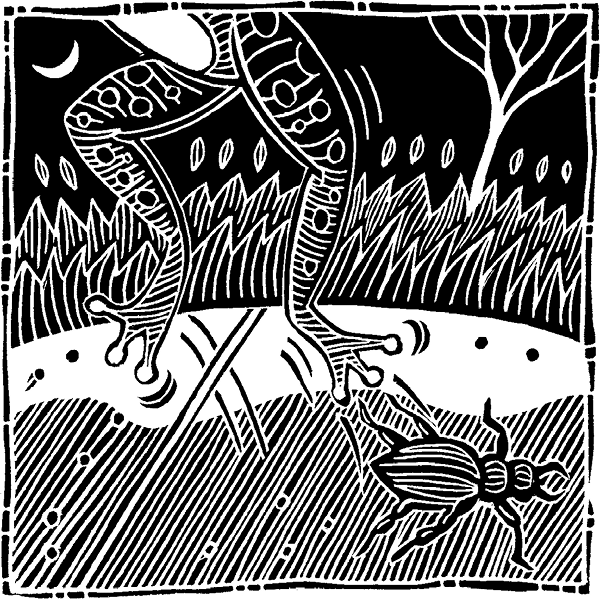Interpreting Omens: When a Black Cat Crosses Your Path, Does It Mean a Darn Thing?
Diana Rajchel
Life’s chaos came on strong during a recent Mercury retrograde with its attached supermoon. Some young men assaulted my sweetie during his weekend run. A few days later, we discovered I needed surgery—pronto. The very next day, my sweetie totaled the car we shared, leaving us without transportation to the hospital. Our pool of friends helped us work that out, but then a four-day blackout and a cluster of problems with a car rental left us to lease a car under duress.
Small, weird incidents happened at the time, too. A woman accosted me for taking a picture of a flower. Three unrelated people, all of whom I had no interest in reconnecting with, contacted me on the same day. An intern I had struggled to train quit just as she found a work rhythm. The onslaught left me confused, looking for meaning in the extreme string of events weaving through our lives.

The calm night came as an oasis from the craziness. As roses bloomed and heat kissed our skin, my sweetie and I made our nighttime rounds of our neighborhood. It felt nice to do something as banal as go for a walk. We paused at our favorite places—the park with the glowing sculptures, the bridge over the drainage field—and then strolled by the quirky houses that mixed Wild West with Great White North. While I took in the big picture, my partner looked at the details that blurred past him on his daily runs. One detail jumped out at him.
He paused midstep. “Oh hey! Froggie!” A toad sat squarely in our path, at the edge of a cement driveway. As we paused to inspect it, the toad hopped away, almost hitting the edge of my partner’s sneakers. At a perfect 180-degree angle, a beetle the size of a half dollar scuttled away from the toad.
I felt a tingle across the top of my feet. It made me want to step out of the line we were about to cross. I knew my sweetie would argue with me about it—going two blocks out of our way to avoid a beetle and a frog. After the cascade of prior events, my paranoia was a natural but still-to-be-questioned reaction. I stepped through, keeping my misgivings to myself.
A toad and a beetle right in our way had all the marks of an omen. It also had all the marks of a little kid playing. I did not need life to get any weirder. My visceral reaction told me that the creatures’ appearance meant something. I hoped it meant something minor.
My last encounter with a toad had turned into a bad omen because I was careless. I mistook one for a rock while cleaning stones out of my garden. When one “stone” blinked at me, I threw it in surprise. I probably hurt it. Upon looking up the meaning later, I found out that killing a toad guarantees bad luck.
I don’t live in that home anymore. It was sold to new owners who raised the rent two months later. That only started the downslide of an exceptionally difficult year. Now, a toad in my path gave me pause.
I worry enough when omens appear to me. Omens appearing to my skeptical partner worry me beyond reason. I wondered, why wasn’t this toad eating this beetle?
As I observed, time seemed to slow. The tingle across the top of my feet increased. I stood on the edge of a secret border: frog and beetle on one side, me on the other. I did not sense the revulsion I normally do for most six-legged creatures. All of this happened at twilight.
Indeed, we had encountered an omen.
I had no way of knowing whether what I saw was good or bad. I just knew it meant something.
Interpreting Omens
Omens are tricky to interpret, especially in North America, where ancestries merge and blur. We do look to animal behavior, to wind direction, to folklore, to divine meaning. Yet one cultural influence may negate the symbolic meaning of another.
Dream dictionaries, founded on Western concepts, can help. While rarely useful in defining dreams, they are often stunningly accurate when interpreting omens in waking life.
On the way home, I looked up the meaning of the toad on my phone. The toad, according to that dictionary, indicates closeted feelings. I sought a second opinion in a different dream dictionary at home. This source suggested a tendency to hide from beauty.
All sources defined the beetle as a warning. Most beetles represent destructive forces at work. I was ready to receive the warning after all the disasters but felt at a loss as to what else to do. One dictionary made a caveat for scarab beetles, but as far as I knew, scarabs did not exist in Minnesota. Then I looked up this beetle: the Minnesota dung beetle, relative to the famed scarab.
It takes practice to recognize and read omens. Human beings are most inclined toward omen reading during times of stress—and times of stress are when we are most likely to misinterpret them.
Two dubious symbols had literally crossed our path. The meaning did not lie in the creatures alone, but in their behavior. Although it had seemed that they wanted us to see them, they had bailed off our path as fast as possible.
It takes practice to recognize and read omens. Human beings are most inclined toward omen reading during times of stress—and times of stress are when we are most likely to misinterpret them. It helps to look for certain physical hallmarks. When you observe the phenomena, do you get a sense of time slowing down? Does the scene draw your attention away from your surroundings? Is the behavior of what you observed typical? Maybe something you noticed but thought trivial keeps popping up in your mind later. All these indicate a possible omen. The only way to know is to consider what you saw and see how its symbolism fits with what is already going on in your life.

Omens often appear simply because you asked. If you requested a sign relating to a concern, the omens encountered communicate with you.
Omens can happen indoors or out, with animals, insects, objects, or people. As long as it has meaning to you, it has meaning as an omen. For example, once as I walked down my apartment hallway, I saw a cat that looked like it had clawed its way out of a Stephen King novel stalking the hallway. It paused at each doorway to scratch and yowl. No doors opened. Who in their right mind would let that thing in their home? A neighbor passed me in the hallway and asked, “Is that cat yours?”
“No, that thing is not my doing.” The odd words from my own mouth surprised me. That casual exchange between neighbors had the slowed-time effect of an omen. I later looked up “cat” in a dream dictionary. Per that source, a cat yowling meant someone was speaking ill of me to anyone who might listen. The reactions from my neighbors—both the one in the hall and the ones who did not let that cat in—told me that the results of these people’s efforts would be unsuccessful.
The scary cat only started that particular conversation. A few days later, on a walk in the woods, I encountered a raccoon pacing back and forth and hissing. This signified that the rumor-mongering continued. As I progressed on my walk, I saw an owl watching me. It was a message from Athena: she observed and was taking my side. Greater wisdom would prevail.
The trickiest omens to interpret are those that use human beings as the symbolic messages. Some strange encounters are just people acting out their foibles and symptoms. Some are not. Mythology is rife with stories of gods and ancestors that venture out among mortals in disguise. The man in the three-piece suit skateboarding down the center line of city traffic might be an entry-level employee getting his kicks. Or he might be Hermes, signaling an incoming message. The gods have modern interests, and that interest includes you.
Once, when I walking to work downtown, a man stopped me on the street to ask me directions to the nearest post office. He wore a gray suit and a top hat and held a cane he did not use. “May I comment on your appearance?” he asked. I said, “Sure,” hoping this wouldn’t turn into a diet advertisement. He looked me up and down. “Very casual.”
I had spent the night before fretting over whether my outfit suited my bank job. The encounter showed all the signs of an omen. Time slowed—I have no memory of anything that went on in the background, despite this man stopping me on a busy city street. He asked a question about a message delivery service.
You can also figure out omens with nonlinear journaling and divination. You can confirm or deny an incident by asking Tarot cards or runes, “Did X event mean something?” Using a journal, write down incidents that concern you on the edges of a page. In the center, free-associate; write down any small but striking incidents that come to mind. Symbols may pop out at you—your subconscious noticed, even if you didn’t.
A walk around the block can expose all sorts of messages. Some are warnings, such as the person yelling rude things while driving by, or the playground you pass where one child bullies others as the bully’s mother looks on, doing nothing. But others are good tidings, like finding a scarab beetle or seeing the clouds parting from the sun. If you happen to believe that nature is God manifest, then omen reading is an ideal way to have a face-to-face conversation. Go be in it and see what the arrangements say to you.
Recommended Reading and Apps
Dream Sight: a Dictionary for Interpreting Any Dream by Dr. Michael Lennox. Woodbury, MN: Llewellyn, 2011.
Dream Moods, http://www.dreammoods.com. This is also available as a smartphone app, with an exhaustive review of dream symbolism.
DreamForth. This is another smartphone app, which looks at dreams in thematic passages.
Diana Rajchel lives in northeast Minneapolis with her life partner. She is the author of the book Divorcing a Real Witch and the executive editor for the Pagan Newswire Collective.
Illustrator: Christa Marquez
Practices, Rituals & Spells
